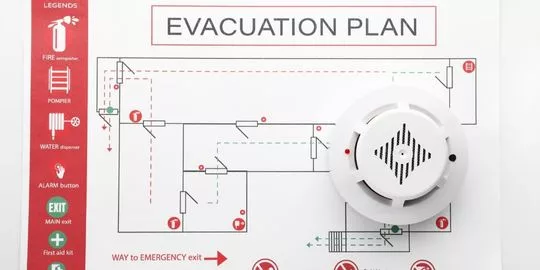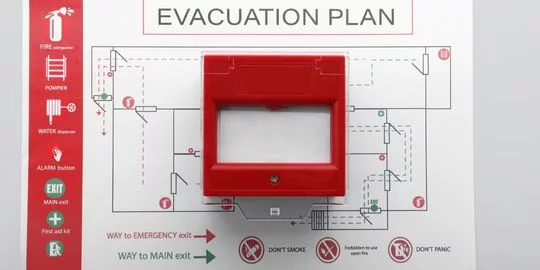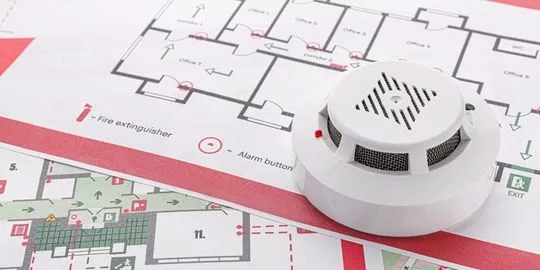A fire safety PEEP is a personal plan designed for individuals who need assistance when evacuating a building or commercial premises in the event of a fire. For example, someone with limited mobility or vision may struggle when attempting to leave a building. Generally, the key question we ask our customers is “can this person evacuate the building safely when unaided?”. If the answer is “no” then we would need to supply this person with a PEEP. The acronym PEEP stands for a personal emergency evacuation plan. Fire safety PEEPs are personal to the individual and based on their requirements when evacuating the building during a fire. In the event of a fire, you’ll need to acknowledge the most efficient and quickest way to get out of a building safely.
This may be an evacuation chair or sledge. If you’re not sure whether you need a PEEP, our fire safety experts can advise on the best course of action.

What Does PEEP Stand For In Fire Safety?
In fire safety, “PEEP” stands for “Personal Emergency Evacuation Plan.”
What Is A Fire Safety PEEP?
If you need a PEEP, it’s important to identify the type of support needed. This will ensure that your evacuation plan is tailored specifically to your needs. If you have trouble walking, then we may suggest the use of an evacuation chair, walker or crutches. Alternatively, if mobility is not an issue but stamina is low then we can help to devise ways to keep you safe in an emergency situation when unaided.
A key question to ask, as mentioned above, is can this person evacuate the building on their own? A fire safety PEEP should be used when an individual is affected by a disability. This includes mobility impairments, sight impairments, hearing impairments, cognitive impairments, a medical condition or injury. Sometimes, an individual’s fire safety PEEP is only required for a limited amount of time. This could be due to a number of factors including pregnancy or a broken leg for instance.
Our fire safety professionals will be able to advise on the best course of action and develop a plan that meets your needs.
What Is A Fire Safety GEEP?
A GEEP is a Generic Emergency Evacuation Plan. It is designed to be used by all people in an emergency. The GEEP focuses on evacuating an individual from a location and getting them to safety. The plan should include information about where you are, the nearest fire exits and how to use them, plus the number of steps required to get out of the building safely.
What Is In A Fire Safety PEEP?
Unlike GEEP, better known as a general emergency evacuation plan. A Personal Emergency Escape Plan (PEEP) is a written document that helps those with impairments prepare for and respond to emergencies. A fire safety PEEP must include:
- Specific evacuation routes where appropriate.
- Refuge areas and specific evacuation procedures.
- Specialist equipment such as an evac-chair that is needed.
- Staff responsibilities.
- Staff training requirements.
- Any building adaptations that are required.
The fire safety PEEP should be reviewed with everyone who is likely to be involved in an emergency. This should be kept up-to-date or at least have annual reviews. If the fire safety PEEP is not well known or understood by staff it will not be effective.
Please discuss with a member of staff what they may need in the case of an emergency. It is not acceptable to assume that all disabled people need help. Additionally, these individuals may wish to use a different method of evacuation than you are offering. If employees are required to go downstairs in an emergency you can offer evacuation chairs, sledges and more.

Does Everyone With A Disability Need A Fire Safety PEEP?
A fire safety PEEP is not always required for those with impairments or disabilities. We must first consider whether the person can evacuate the building unaided.
- If the answer is YES, then they will not require a PEEP.
- If the answer is NO, then they will need a fire safety PEEP.
There are many different types of impairments and disabilities that affect the evacuation. It’s important to be aware of the individual needs of each person.
The fire safety PEEP should be reviewed by all responsible staff involved in fire safety. The reason for this is that they may be responsible for helping people to evacuate or providing first aid if they are injured during an emergency.
The Aim Of A PEEP
A PEEP is designed to provide people who cannot get themselves out of a building without assistance with the information and backup they will need in case they find themselves stuck in an emergency.
Responsibilities
The manager, responsible person or nominated representative is responsible for talking to disabled staff, service users and visitors in order to assess whether they require any assistance should an emergency arise.
If a person believes that he or she might need assistance, the PEEP Questionnaire should be completed. This should always be done by the Responsible Person and/or their nominated representative and if possible in liaison with whoever has a disability/mobility impairment.
Writing the PEEP
Data from the questionnaire should be used to create a PEEP. Different types of buildings have different characteristics, and people with disabilities may need a Personal Emergency Evacuation Plan tailored to the features found in each building they regularly use.
If assistance is required to implement the escape plan, details of how this will be arranged should be specified in the PEEP (including who will provide it and what form it will take). It is necessary to ensure that there are enough people to cover when key personnel cannot attend, and those involved may need training.

Conclusion
If you follow the above steps, then it should be possible to provide a suitable fire safety PEEP for all employees. The fire safety PEEP will provide guidance on how to assist people with disabilities in the event of a fire. It should be reviewed by all staff members who may be responsible for providing assistance to disabled people during an emergency. This includes not just those who work in the building, but also visitors of the company premises.
If you are responsible for developing a fire safety PEEP, then it is important that you ensure that it is kept up to date. In addition, when new equipment is purchased or installed, then it should be included in the PEEP. Generally, all staff should be trained on how to use this equipment. If any modifications are made to the premises or layout of your building, then these changes should be recorded in the fire risk assessment document.
Fire Risk Assessment In Derby
A fire risk assessment is a thorough inspection of your premises to identify potential sources of fire and determine how best to protect against them. A good fire risk assessment looks at the full range of hazards that may be present in your building, from electrical equipment through to construction materials. It’s a good idea to get your fire risk assessment done every year. In this way, you can keep track of any potential hazards and take steps to remove them before they become an issue.
We offer a full range of fire risk assessment services for businesses in Derby and the surrounding area. Our team of qualified professionals will carry out a thorough inspection of your premises, identifying any potential sources of fire and determining how best to protect against them. We’ll also provide you with a comprehensive report on our findings so that you can keep track of any changes over time.
If you’re looking for a fire risk assessment in Derby, then please get in touch with us today on our contact form.
